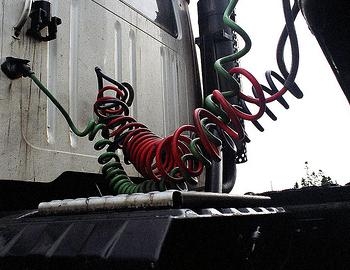
When an 18-wheeler is hauling a heavy load cross country in the winter, it can take all of the driver's skill to get it there safely. Air brakes that work properly are critical for any big rig driver. Knowing that when you depress the brake pedal you will have enough air pressure to safely stop your heavy load in the snow is vital. By repairing your own air brakes, you can avoid putting your rig in the truck shop or having to call a mobile mechanic. Use these steps to learn how to repair air brakes when you are stuck on the road in wintry weather without having to call for help.
Inspect the air brake system before attempting to repair air brakes that are not working properly. With the engine running, depress the parking brake button and let the air compressor governor begin to raise the air pressure of the system. Listen for escaping air. Also listen to the compressor for problems that can come from a bad air compressor. Low RMP or air pressure that builds up but remains too low to activate the air brakes will need to be fixed at the compressor. Now exit the vehicle and visually inspect the trailer brake system for leaks or buildup of snowy material, which causes leaks.
Tighten the air compressor belt if loose. Use a crescent wrench to tighten the adjustment bracket of the compressor to stretch the compressor belt so that the compressor will generate a higher air pressure within the air brake lines. When the compressor belt is loose, the compressor may raise the air pressure but not high enough to activate the brakes. Now you can see if the added air pressure is enough to activate the brakes properly.
Bang the air brake drums with a rubber mallet. During the harsh winters of the Northern states, air brakes can become contaminated with ice and snow. Both can create air leaks or clog an air line or jam an air brake drum because of the cold. Once you have hit the rubber mallet around the outside of each drum go to the air lines that connect the tractor to the trailer.
Clean the connectors of the air lines to the trailer. Make sure that they are properly seated and free from snow and ice buildup. If the rubber seals on either the air line or the tractor's adapter are damaged, you need to make the best seal possible to correct an air leak that results from this type of damage to the rubber seals. You can use a lubricant to help seat the two seals, but when they are damaged, it is recommended that a new adapter be put on the air line coming from the tractor or the trailer's air line adapter. For ice and snow and cold conditions, you need to free the lines from the ice that has built up inside.
Pour some methyl alcohol into the air compressor's evaporator to help keep the air lines free from ice. The recommended treatment will keep the lines ice-free from the inside out. If you are stuck with ice build up before you pour the methyl alcohol into the evaporator, then you might need to pour some into the lines where the tractor's air lines and the trailer's air line adapter meet. The methyl alcohol will clear the lines from ice, and air will get back to the air brake drums to activate the brakes.
Test the air brake system again after you complete these steps of how to repair air brakes. The winter weather should not be a problem anymore once you have finished. Get back into the tractor cab and test the system using the brake controls inside the cab. Test the parking brake, test the driving brakes, and make sure that the compressor is operating well enough to produce the air pressure needed to activate the brakes again. Minus the snow and ice that can build up during the winter, an air brake system that is repaired correctly will stop a heavy load in any weather.